Orford |
|
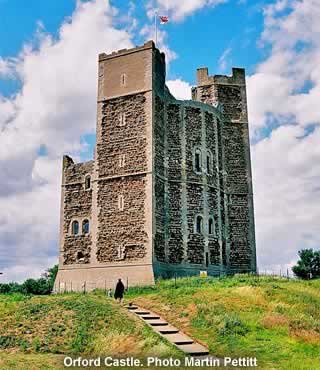 |
|||
An old fishing village, haunted by strange tales from the past |
|||||
|
|||||
Vegetated shingle is a rare, fragile type of habitat for certain birds. Europe's largest example is Orford Ness, on the Suffolk coast. It's a long, thin strip of land, separated from the mainland by the River Alde. For several decades now, the National Trust have run it as an official Nature Reserve. The landscape is easily damaged, so access is limited to certain open days. This is still more than was possible in the 30s, when the shingles were owned by the Ministry of Defence. They carried out all sorts of strange, secret experiments here, including explosive demonstrations and the development of radar. Many of their old buildings still dot the landscape like ominous ghosts. |
|||||
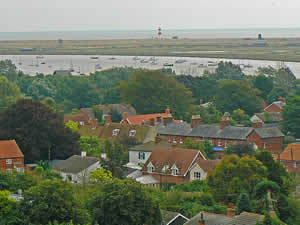 The view from the Castle over the village and Orford Ness |
|||||
There's only one way to get to Orford Ness, and that's by boat from Orford. Nowadays, the town's quay is a peaceful gateway to nature - but that wasn't always the case. It's thought that, many centuries ago, the vegetated shingle hadn't yet formed, and the harbour looked directly out to sea. It was a busy place that welcomed travellers and traders from far and wide. Fishermen have operated here for years too. Seafood is caught in all seasons, from lobsters in spring to herring in winter. Orford's oysters were particularly renowned, but they disappeared from these waters in the early 1900s. It fell to a local man, Richard Pinney, to being them back. He imported oysters from Portugal, and successful reintroduced the hatcheries. They, along with other fresh catches, are widely available in local restaurants. |
|||||
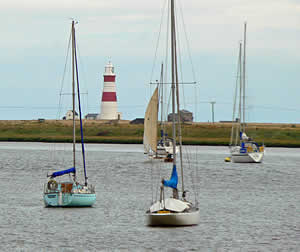 The Lighthouse on Orford Ness |
|||||
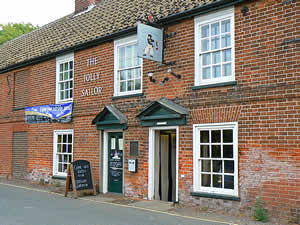 The Jolly Sailor Pub in the centre of Orford |
|||||
Historically, such an important coastal town needed to be kept secure. It's been defended from the very beginning by Orford Castle, a stout, 12th century fortress built by King Henry II. The design of its keep proved to be quite unusual; it's halfway between a classic square shape, and a more modern circular structure. This is the only part of the castle still standing. It's maintained by English Heritage, who open the building to the public. If you go inside, try not to get lost in the notoriously confusing maze of passages and corridors. |
|||||
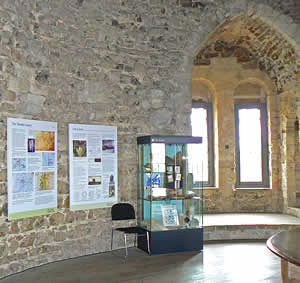 The Main Hall inside the Castle |
|||||
Also within the castle is Orford Museum. It collects information and artefacts from the local area, showing its development over time. So far they've accumulated a wide variety of weapons, decorations, clothing and photographs. The collection has been very helpful to historians, but some aspects of the town's past remain somewhat mysterious. As one exhibit explains, the castle was supposedly the brief home of the Wild Man of Orford. He was pulled out of the sea in a fisherman's net and, while he looked like a normal man, his behaviour was more like that of an animal. The creature was kept here for half a year before it escaped. His image is still visible today, in various paintings and carvings across all the county. Some say this was one of humanity's rare encounters with a real merman. |
|||||
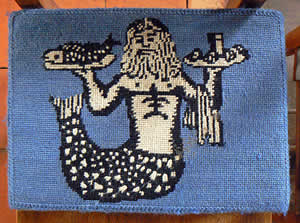 The legend of the Orford Merman or Wildman, shown on prayer mats in the church |
|||||
This is just one of the many strange tales that Orford has to tell. The town seems to collect them, whether it wants to or not. Some people swear blind that they've seen ghosts in the Orford Ness' old World War bunkers. Others have mistaken the lighthouse for a UFO! |
|||||
|
|||||
Orford Castle (EH) is open daily from April to October (plus weekends in winter), 10am to 4pm. Entry costs around £5.60 for adults, £3.40 children. Orford, Suffolk, IP12 2ND. Tel: 01394 450472 |
|||||
|
Pocket Britain is optimised for use on a smartphone or tablet with internet access. All content is subject to copyright. All reasonable methods have been used to ensure information supplied is accurate at the time of publication. However, it is advisable to check information before relying on it. Privacy Policy |